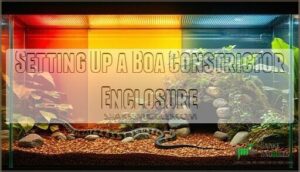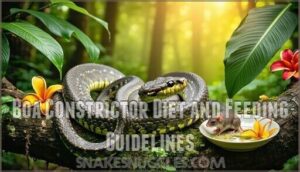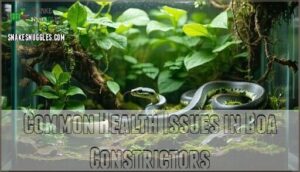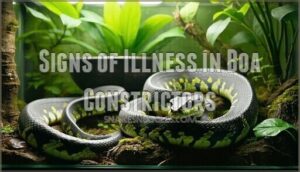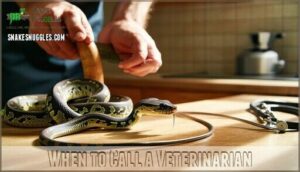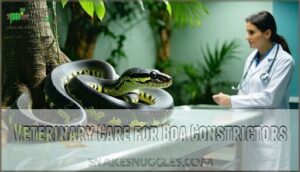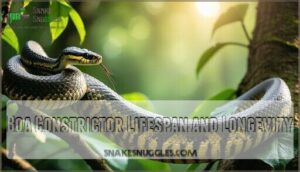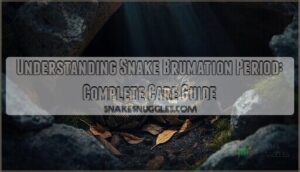This site is supported by our readers. We may earn a commission, at no cost to you, if you purchase through links.
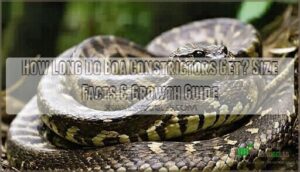 Most adult boa constrictors reach 6-10 feet in length, with females often growing larger than males.
Most adult boa constrictors reach 6-10 feet in length, with females often growing larger than males.
Wild boas typically average 6-8 feet, while captive specimens frequently exceed 10 feet due to consistent feeding and ideal conditions.
These snakes start at just 18-24 inches as hatchlings but grow rapidly, doubling their size within the first year.
Some exceptional females can stretch beyond 13 feet and weigh over 30 pounds, with the record-holder "Fluffy" reaching an incredible 24 feet, though such giants are extremely rare.
Your boa’s final size depends heavily on genetics, nutrition quality, and housing space, and understanding growth patterns helps you plan proper housing as your snake matures.
Table Of Contents
- Key Takeaways
- Boa Constrictor Size and Growth
- Boa Constrictor Habitat and Space Requirements
- Boa Constrictor Diet and Feeding Guidelines
- Boa Constrictor Health and Veterinary Care
- Boa Constrictor Lifespan and Longevity
- Frequently Asked Questions (FAQs)
- How long do boa constrictors grow?
- How long do boa constrictor snakes live?
- How big do boa constrictor Imperators get?
- How tall is a boa constrictor?
- What drives boa constrictor growth?
- What is the difference between a male and female boa constrictor?
- How long is a full grown boa constrictor?
- What is the longest boa constrictor on record?
- How big do boas get in captivity?
- How big is a 1 year old boa constrictor?
- Conclusion
Key Takeaways
- You’ll find that most adult boa constrictors reach 6-10 feet in length, with females typically growing larger than males by about 30%, which affects their full adult size.
- Your boa will start as an 18-24 inch hatchling and double in size within the first year, reaching full adult size in 3-5 years.
- You can expect your captive boa to grow larger than wild specimens due to consistent feeding and ideal conditions – captive boas frequently exceed 10 feet while wild ones average 6-8 feet.
- Your boa’s final size depends heavily on genetics, nutrition quality, and housing space, so you’ll need to plan for proper enclosure upgrades as your snake matures over its 20-30 year lifespan.
Boa Constrictor Size and Growth
When you’re considering a boa constrictor as a pet, you’re probably wondering just how big these impressive snakes can get.
Most adult boas reach 6-10 feet in length, though some exceptional females can stretch up to 13 feet or more.
Average Length and Weight of Boa Constrictors
When considering boa constrictor size, you’ll find these serpents typically reach 6-10 feet in captivity, with females growing larger than males.
Adult boas commonly weigh 22-33 pounds, though exceptional specimens can exceed 60 pounds.
Here’s what affects their impressive measurements:
- Length Records: Wild boas average 6-8 feet, while captive specimens often reach 10+ feet
- Weight Factors: Females can be 30% heavier than males of equal length
- Snake Growth: Hatchlings start at 18-24 inches, doubling their length within the first year
These constrictor measurements help you plan appropriate housing and care for your growing snake.
Factors Affecting Boa Constrictor Growth
Your boa’s growth rate depends on genetic influence, dietary needs, environmental impact, and space requirements.
Your snake’s size can vary dramatically: Boa constrictor imperator typically reaches 6-8 feet, while B. c. constrictor can exceed 10 feet. Females grow 30% larger than males.
Proper nutrition, adequate enclosures, and ideal temperatures directly affect your snake’s boa constrictor length potential. Understanding the importance of enclosure size guidelines is vital for promoting healthy growth and development in boa constrictors, which is also influenced by boa constrictor size.
How to Measure Your Boa Constrictor’s Length
Accuracy matters when tracking your boa constrictor’s growth over time.
Use a flexible measuring tape for precise length tools and gentle snake handling techniques.
Position your boa straight from snout tip to tail end, avoiding curves or bends that skew measurements.
Record monthly measurements for effective growth tracking and reliable size estimation data.
Weight and Length Charts for Boa Constrictors
Once you’ve measured your boa constrictor length, tracking growth becomes straightforward with standardized charts.
These measurement accuracy tools help monitor your snake’s development through different length stages and weight ratios.
- Growth percentiles: Males average 6-8 feet (13-16 lbs), females 7-10 feet (25-30 lbs)
- Age correlation: Most reach adult boa constrictor size within 3-5 years
- Length stages: Juveniles grow 2-4 feet, adults plateau at maturity
- Weight ratios: Exceptional specimens may exceed 60 lbs and 10+ feet
Boa constrictors are sometimes kept as home pest controllers to manage rodent populations.
Boa Constrictor Habitat and Space Requirements
Your boa constrictor’s size directly determines how much space it needs to thrive in captivity.
The right enclosure setup guarantees your snake can stretch, move naturally, and maintain proper body temperature for healthy growth.
Minimum Tank Size for Boa Constrictors
Your boa constrictor needs proper housing that matches its impressive snake length potential. Adult boas require different space allocations based on their boa constrictor size – understanding this relationship between space vs. growth helps prevent stunted development.
A suitable habitat often includes a bioactive substrate to maintain humidity and allow for natural behaviors.
| Snake Length | Tank Dimensions | Vertical Space |
|---|---|---|
| Under 7 feet | 4′ x 2′ x 2′ | 2 feet minimum |
| 7-10 feet | 8′ x 3′ x 3′ | 3 feet preferred |
| Over 10 feet | Custom enclosure | 4 feet ideal |
Tank materials like PVC or glass work well for cleaning frequency maintenance, while enclosure enrichment promotes healthy boa constrictor growth patterns in your snake enclosure.
Setting Up a Boa Constrictor Enclosure
Creating your boa constrictor habitat requires careful attention to enclosure size and environmental controls.
You’ll need proper substrate choice like cypress mulch for humidity control, while ensuring adequate ventilation needs are met.
Design your snake enclosure with a temperature gradient from cool to warm sides, incorporating hiding spots and secure access points.
Consider the appropriate enclosure dimensions for your boa’s health.
This boa constrictor care approach supports ideal reptile habitat requirements for healthy pet habitat design.
Temperature and Humidity Requirements
Proper temperature and humidity management forms the foundation of successful boa constrictor care. You’ll need to establish ideal temperature gradients ranging from 75-85°F on the cooler side to 86-90°F on the warmer side, while maintaining humidity levels between 60-70%.
This gradient importance can’t be overstated for boa constrictor growth and overall health. Consider these environmental conditions that directly impact your snake’s wellbeing:
- Monitoring equipment like digital thermostats prevents dangerous temperature spikes
- Humidity effects include proper shedding and respiratory health
- Seasonal adjustments may be needed as your home’s climate changes
- Poor reptile habitat requirements lead to stressed, unhealthy snakes
- Consistent boa constrictor length development depends on stable conditions
Substrate and Decorations for Boa Constrictor Tanks
Your boa’s constrictor habitat needs the right foundation and enrichment to thrive. Choose substrate types like aspen or cypress mulch for ideal reptile habitat requirements.
Avoid sand and gravel, which cause respiratory problems. Add hiding places, climbing branches, and shallow water features for mental stimulation.
Follow proper cleaning protocols by spot-cleaning weekly and replacing substrate monthly. Consider boa substrate options for superior reptile health.
Your pet habitat design should balance functionality with your snake’s natural behaviors.
Substrate Decorations
Boa Constrictor Diet and Feeding Guidelines
Your boa constrictor’s diet directly impacts how large they’ll grow, making proper feeding essential for reaching their full size potential.
You’ll need to understand what to feed them, when to feed them, and how to recognize signs of good health to guarantee healthy growth.
Prey Items for Boa Constrictors
The right prey items fuel your boa’s growth and health.
You’ll need rodents matching your snake’s size—from pinky mice for hatchlings to adult rats for mature boas.
Essential boa constrictor feeding considerations:
- Prey Size: Choose rodents 1-1.5 times your boa’s head diameter
- Rodent Types: Mice for juveniles, rats for adults, occasional chicks for variety
- Meat Options: Pre-killed frozen/thawed prey prevents injury and parasites
- Feeding Tips: Source from reputable suppliers to avoid toxins
- Hunting Strategies: Offer appropriate-sized prey to support natural feeding behaviors
When selecting pre-killed rodents, consider the benefits of frozen mouse options for a convenient feeding solution.
Feeding Schedule for Boa Constrictors
Smart feeding habits keep your boa constrictor thriving throughout its life.
Baby boas need meals every 7-10 days, while adults can go 2-4 weeks between feedings.
Monitor your snake’s weight and adjust meal timing accordingly.
Proper feeding frequency maintains steady digestion rate and maintains ideal body condition for healthy growth and development.
Understanding boa constrictor feeding is vital for providing the right care.
How to Thaw Frozen Prey
Frozen prey requires careful thawing methods to maintain your boa constrictor’s nutrition.
Water baths work best—submerge sealed prey for 30-60 minutes depending on size.
Refrigerator thaw overnight offers another safe option for snake feeding.
Never microwave frozen prey; uneven heating creates hot spots that’ll burn your snake’s mouth.
Proper boa constrictor care starts with safe snake feeding habits.
Signs of a Healthy Boa Constrictor
Proper feeding sets the stage for monitoring your boa constrictor health indicators.
A healthy snake displays clear, bright eyes and smooth shedding patterns that occur every 4-8 weeks.
Good muscle tone shows when your snake moves with purpose and strength.
Their activity level should be consistent with regular exploration periods.
- Eye Condition: Bright, clear eyes without cloudiness or discharge indicate excellent boa constrictor health
- Shedding Patterns: Complete sheds in one piece every 4-8 weeks show proper skin health and growth rate
- Muscle Tone: Firm body with visible definition when moving demonstrates good boa constrictor size development
- Activity Level: Regular movement and feeding responses reflect ideal boa constrictor care practices
- Overall Appearance: Rounded body shape and alert behavior suggest healthy boa constrictor lifespan potential
Boa Constrictor Health and Veterinary Care
Keeping your boa healthy requires knowing what to watch for and when professional help’s needed. Regular veterinary care prevents serious problems and guarantees your snake lives a long, comfortable life.
Common Health Issues in Boa Constrictors
Even with excellent feeding practices, boa constrictor health issues can still emerge.
Watch for respiratory issues like wheezing or mouth breathing, parasite control problems causing weight loss, skin problems during shedding, and metabolic disease from poor nutrition.
Infection signs include lethargy, discharge, or appetite changes.
Spotting these early prevents minor issues from becoming major threats to your boa constrictor lifespan.
Signs of Illness in Boa Constrictors
Spotting illness in your boa constrictor requires watching for subtle behavioral changes that signal trouble.
These snakes hide illness well, making early detection essential for successful treatment.
Here are three key warning signs to monitor:
- Lethargy Signs and appetite loss – Your normally active snake becomes sluggish or refuses food for extended periods
- Respiratory Issues – Wheezing, mouth breathing, or excessive mucus indicate potential infections requiring immediate attention
- Shedding Problems – Incomplete sheds, retained skin pieces, or abnormal shedding cycles suggest underlying health concerns
Watch for changes in defecation patterns, unusual posturing, or visible parasites.
Early intervention prevents minor issues from becoming serious reptile health emergencies.
When to Call a Veterinarian
Don’t wait when your boa shows concerning symptoms. Lethargy, appetite loss, respiratory distress, or unusual behavior warrant immediate Medical Help.
Snake Illness can escalate quickly, making timely Vet Visits critical. Emergency Care becomes necessary if breathing appears labored or your snake refuses food for weeks.
Regular Health Checks help catch problems early, supporting overall boa constrictor health issues prevention and longevity.
Veterinary Care for Boa Constrictors
Finding qualified veterinary care keeps your boa constrictor healthy throughout its impressive lifespan. Reptile vets understand boa constrictor health issues better than general practitioners, offering specialized knowledge about boa constrictor growth rate and size variations.
They’ll provide emergency care when needed and guide you through proper boa constrictor care practices. Consider these veterinary tips for maximal boa constrictor longevity:
- Schedule annual check-ups to catch problems before they become serious health crises
- Discuss parasite control protocols to prevent internal parasites from stunting growth
- Ask about snake surgery options if your boa develops tumors or reproductive issues
- Establish emergency care plans for respiratory infections or feeding problems
Regular health checks involve evaluating the boa’s reptile specific needs to guarantee a long and healthy life.
Boa Constrictor Lifespan and Longevity
You’ll want to know how long your boa constrictor will be your scaly companion, especially since they’re a decades-long commitment.
Understanding their lifespan helps you plan for proper care throughout their entire life, from juvenile to senior snake, which is crucial for a healthy life.
Average Lifespan of Boa Constrictors
Boa constrictor longevity varies dramatically between environments.
In the wild, these serpents typically survive 20 to 25 years, facing predators and environmental challenges.
Captive boas with proper boa constrictor care routinely reach 25 to 30 years, with exceptional specimens hitting 40 years.
That’s four decades of snake companionship! Age records show the oldest documented boa lived over 40 years at Philadelphia Zoo, proving boa longevity potential.
Factors Affecting Boa Constrictor Longevity
Beyond genetics, boa constrictor longevity depends heavily on Environmental Impact and Nutrition Effects.
Poor diet shortens lifespan dramatically. Stress Factors like inadequate space or improper Climate Conditions create health complications.
Consistent temperatures, quality prey, and spacious enclosures maximize boa constrictor lifespan.
Genetic Influence sets the foundation, but your care determines whether your snake reaches its full potential or suffers premature boa constrictor health issues.
Record-Breaking Boa Constrictors: The Longest and Oldest
While many factors influence longevity, some boa constrictors have achieved remarkable records.
The longest boas include "Fluffy," holding the Guinness World Record at 24 feet.
For extreme growth and record boa lengths, captive specimens occasionally reach 12-14 feet.
Giant constrictors like "Popeye" lived over 40 years, demonstrating exceptional boa constrictor lifespan beyond typical averages, with some achieving remarkable records.
Frequently Asked Questions (FAQs)
How long do boa constrictors grow?
Adult boa constrictors typically reach 6-10 feet in length, though some can grow up to 13 feet. Females generally grow larger than males, with exceptional specimens reaching 18 feet.
How long do boa constrictor snakes live?
Like knights of old who lived by the sword, you’ll find that boa constrictors enjoy remarkably long lifespans.
In captivity, they typically live 20-30 years, with exceptional individuals reaching 40+ years through proper care.
How big do boa constrictor Imperators get?
Boa constrictor imperators typically reach 6-10 feet in length, with females growing larger than males.
Exceptional specimens can reach 13 feet, though this is rare.
Growth depends on genetics, diet, and housing conditions.
How tall is a boa constrictor?
Standing, stretching, measuring – you’ll find boa constrictors aren’t typically described by height since they’re horizontal creatures.
When coiled, they’re roughly 12-18 inches tall, but length matters more than vertical measurement for these serpents, and understanding this is key to grasping the importance of measurement in describing them.
What drives boa constrictor growth?
Your snake’s growth depends on genetics, diet quality, available space, and environmental conditions.
Consistent feeding schedules, proper temperatures, adequate habitat size, and good health directly influence how large your boa will ultimately become, which is also dependent on diet quality.
What is the difference between a male and female boa constrictor?
You’ll notice females grow larger, typically reaching 7-10 feet compared to males at 6-8 feet.
Females also develop broader heads and thicker bodies for egg production, while males stay more slender throughout their lives.
How long is a full grown boa constrictor?
You’d think something called a "constrictor" would stay small, but full-grown boa constrictors typically reach 6-10 feet long. Females grow larger than males, sometimes hitting 13 feet.
What is the longest boa constrictor on record?
The longest boa constrictor on record reached eighteen feet in length.
This exceptional size far exceeds the typical adult range of six to ten feet, making it a remarkable specimen in herpetological records.
How big do boas get in captivity?
Like Victorian-era serpentarium keepers discovered, you’ll find captive boas typically reach 6-10 feet, though females can hit 13 feet with proper care, consistent feeding, and adequate enclosure space.
How big is a 1 year old boa constrictor?
Your one-year-old boa constrictor will typically measure between 3-4 feet long.
Growth depends on genetics, diet quality, and habitat conditions.
They’re past their rapid newborn phase but still growing steadily toward adult size, influenced by factors such as diet quality.
Conclusion
Like something from a medieval bestiary come to life, your boa constrictor will transform from a tiny hatchling into an impressive serpent.
Understanding how long do boa constrictors get helps you prepare for decades of companionship with these remarkable reptiles.
Most reach 6-10 feet, though exceptional specimens exceed 13 feet.
Proper nutrition, adequate housing, and regular veterinary care guarantee your boa reaches its genetic potential while maintaining peak health throughout its 20-30 year lifespan.
- https://www.nationalgeographic.org/animals/reptiles/b/boa-constrictor/
- https://darrenhamillreptiles.com/boa-constrictor-husbandry/
- https://reptileschool.com/boa-constrictor-size/
- https://nationalzoo.si.edu/animals/boa-constrictor
- https://www.reddit.com/r/boas/comments/1i72ph3/how_big_do_male_boa_constrictors_get/


